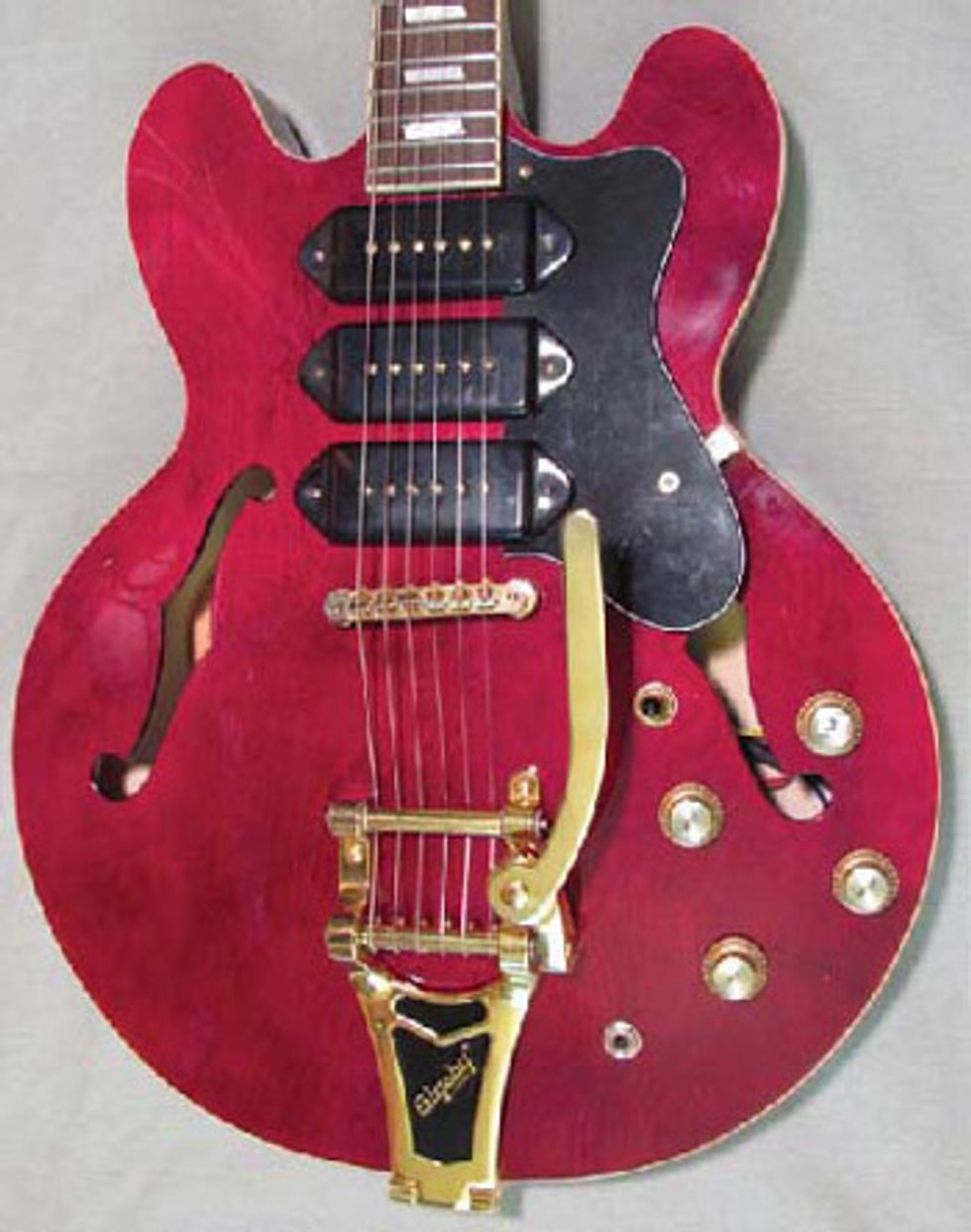 |
I did my homework first. With a list price of $832 and a street price of $499, that gave me an idea of a P93’s new value. But we don’t play that game. So the next step was to find a used one within my bottom-feeder range of $300–$400. Since P93s were only introduced in 2008, there were very few around. I was diligent, though, and after a few weeks started seeing more and more of them for sale on eBay. However, I noticed there was a bunch of these for sale with shipping damage, as if a speeding train hit a shipping container full of P93s. There were all kinds of Riviera Custom P93s on eBay with neck, headstock, and body damage. That meant I had to be careful, because there might be some recently repaired ones being resold that could have potential problems down the road.
I found this one offered as a seven-day auction with an opening bid of $299. I bookmarked it, and on the seventh day sent in my elite Navy Seal team to go into bidding battle for me. In other words, I “sniped” in the last five seconds, winning the guitar for $306—a very good deal with added shipping of only $17.50. I was really excited when it arrived about 10 days later. There was no case included, and it was rather poorly boxed, which could have led to shipping damage. But I examined it thoroughly and found nothing wrong.
However, when I went to plug the guitar in, I found that the output jack was loose. While trying to tighten it, I discovered the threads on the jack’s nut were stripped badly. After plugging in a few times, the jack dropped inside the body. I had remembered seeing a few of these guitars on eBay with loose jacks that had also fallen inside the body. Those guitars were sold at a discount for the buyer to fix. It made me suspicious that the seller might have bought one of these and jerry-rigged the jack as best he could before reselling it. Hmmm.
Because hollowbody Gibsons and Epiphones do not have access covers on the back, replacing a jack means taking all the electronics out first—a formidable task. I contacted the seller, explained the situation, and asked for a $35 partial refund to get it repaired. He counter-offered with a $25 refund. After thinking about it, I took the offer, figuring that the guitar was still a great deal. I received his PayPal partial refund, and after I was satisfied with everything else, I left him positive feedback.
Bottom Feeder Tip #2877: Never leave positive feedback until you have taken enough time to really be happy with a transaction. Once feedback is left, it cannot be undone—game over. It’s a fact: eBay is a buyer’s market, meaning that buyers have most of the power, and positive feedback is how we buyers level the playing field. Since sellers cannot leave negative feedback, they have little power.
The way the P93 is wired is quite different from other triple-pickup guitars. Instead of a 5-way switch, it has a 3-way toggle for selecting the neck pickup, the bridge pickup, or both those units together. Because each pickup has its own Volume control, you bring the middle pickup in and out with its Volume—it doesn’t have a switch. This scheme yields a total of six combinations. In fact, you can get a seventh combination by turning down the bridge and neck pickups while leaving the middle one turned up. This setup offers very interesting combinations for a P-90 equipped guitar, and provides lots of tonal options when you start blending the levels.
Sadly, the guitar sat in the corner of my studio for about six months before I finally decided to get the jack fixed. I found a repair guy in Asheville named Jack Dillon, who came highly recommended. He also noticed reduced output from the bridge pickup, which was due to the previous owner reversing the bottom alnico magnet for unknown reasons. Jack was able to replace the output jack, reverse the bridge magnet, and lower the string slots at the nut for a total of $40—a very reasonable sum, even for a bottom feeder. I had him replace the gold-plated jack with a standard chrome one we both thought would be more stable. In a classic bottom-feeder move, I took a red Sharpie to it and smeared the ink a little. Now the jack blends in more and looks, well, gold-ish. Good enough for me.
In the end, the guitar cost me a total of $338.50, but now it’s easier to play, it’s much more stable, and it sounds better, to boot. You can’t beat that! It’s especially hip for blues and rockabilly— almost like a Strat trapped inside a 335 body. So is it a keeper? Yep. She’s now part of my arsenal.
 Will Ray
is a founding
member of the
Hellecasters guitar-twang
trio. He also does guitar
clinics promoting his
namesake G&L signature
model 6-string, and produces
artists and bands at his studio in
Asheville, North Carolina. You can contact
Will on Facebook and at willray.biz.
Will Ray
is a founding
member of the
Hellecasters guitar-twang
trio. He also does guitar
clinics promoting his
namesake G&L signature
model 6-string, and produces
artists and bands at his studio in
Asheville, North Carolina. You can contact
Will on Facebook and at willray.biz.






![Rig Rundown: Russian Circles’ Mike Sullivan [2025]](https://www.premierguitar.com/media-library/youtube.jpg?id=62303631&width=1245&height=700&quality=70&coordinates=0%2C0%2C0%2C0)


























